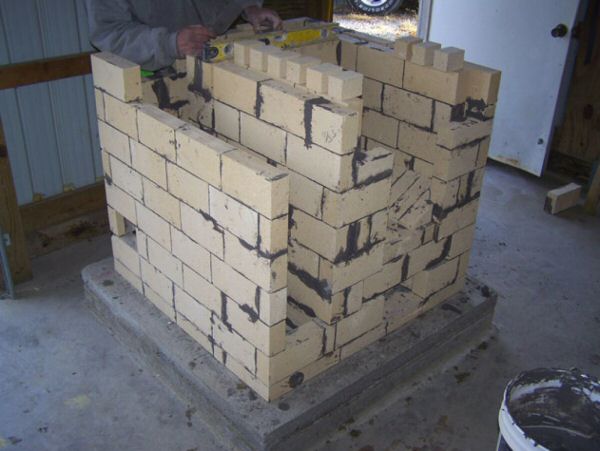

Date: Tue, 15 Dec 2009
Subject: Alex Chernov design we built in Ohio using your web photos.
From: Tom Stacy <tfstacy(at)gmail.com>
To: mheat(at)mha-net.org
We built this same unit in a pole barn in Western Ohio. We finished it in February, 2009, so this is the first full winter it will be in service. It runs on a 1/12, Hp 3-speed Grundfos pump just upstream of the stove/manifold.
The stove/manifold discharge is black piped to a sealed 250 gallon stainless tank that is well insulated (R19 around and R-30 on top). From there the water is forced to the distribution manifold, where it breaks to two (1") oxygen barrier PEX feed lines. Three Ball valves control flow to two forced air units at opposite ends of my 4,500 ft2 house. There is also a bypass gate valve so the house can be bypassed altogether for preheating or maintenance. The PEX lines to the house are insulated with four wraps of mylar coated bubble wrap (that NASA stuff), and slid through a 5" corrugated tile.
For safeties, we have a thermocouple operated fan/coil that kicks on at 175F, and then a cooling solenoid that opens the loop to drain at 190F. When this happens, the well refills just ahead of the manifold to quench. On the pressure side, we have a reducing valve from the well set at 15PSI, and two PRVs - one on the tank and one on the output piping from the manifold. Both pressure relief valves are black piped to an outside tile, along with the cooling solenoid discharge. These are well insulated. We also have a 50 gallon expansion tank, and a bubbler. We have never had a safety actuate from an over temp or over pressure situation. We have had power outages, but I have a generator I can switch to in a hurry to keep the flow going. This is basically just to prevent additional scale build up in the manifold.
The unit takes a lot of wood. We use mostly red elm, some cherry, and some shag bark hickory. It looks like the past month we have used about 2 cords. The rise across the manifold is usually 30 to 35 degrees during each burn. Delta T to the house we try to keep about 25 degrees by keeping the bypass valve cracked open, reducing volume to the house. About 7 to 8 of that is loss is to the ground. (Turning off the air handlers in the house makes that easy to measure) We have test ports everywhere and several portable pressure and temperature gauges. I will also attach a burn chart from our first hot burn in bypass mode.
We covered the firebrick with a course of old schoolhouse clay brick, then about 4" of vemiculite on the unit walls, and a foot on top. It's not near enough. The 28 x 45 pole barn has 10' walls and a 3:12 pitch. It is isocynene foam insulated, and stays in the mid seventies all the time just from the radiant loss off the unit.
My office is in the barn, so I am here to feed wood anyway. It works out great. My mason friend, Dave Wilcox and I built it together, and I designed the hydraulic system.
More info upon request.
Cheers!
Tom Stacy
--
Sequence Photos of my masonry hydronic heater sm.pdf
first trial not to house.xls
Outdoor Rumford fireplace and bake oven by Dave Wilcox, the mason who built the boiler.